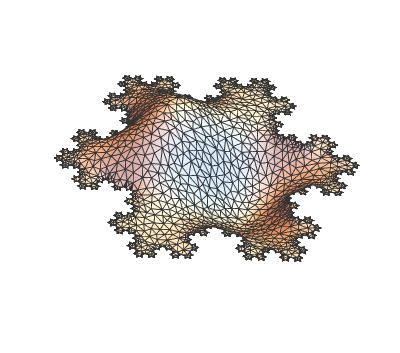Context
While studying manifold Learning I got interested in finding the eigenvectors of the Laplacian. (also in connection to this problem of solving the heat equation)
Following this and that amazing answer, I am interested in solving this Helmholtz equation in 3D
$ \triangledown^2 u(x,y,z) + k^2u(x,y,z) =0 \quad x,y,z \in \Omega\,, \quad u(x,y,z) = 0 \quad {\rm with}\quad x,y,z \in \partial\Omega $
where $\Omega =$ is some 3D boundary e.g. a ball, an ellipsoid, a regular 3D polygon etc.
I have played around with the 2D codes provided here to produce these first eigen modes of a snowflake (again beautiful code!):

They look like this and are super-cool!

but I would like to generalize their answer to 3D.
Question
How would one proceed in 3D, given that we have a 2D solution working?
Cheeky Attempt
I have modified slightly Mark McClure's code to make it 3D savvy, but I am no expert in this field
Needs["NDSolve`FEM`"]; helmholzSolve3D[g_, numEigenToCompute_Integer, opts : OptionsPattern[]] := Module[{u, x, y, z, t, pde, dirichletCondition, mesh, boundaryMesh, nr, state, femdata, initBCs, methodData, initCoeffs, vd, sd, discretePDE, discreteBCs, load, stiffness, damping, pos, nDiri, numEigen, res, eigenValues, eigenVectors, evIF},(*Discretize the region*) If[Head[g] === ImplicitRegion || Head[g] === ParametricRegion, mesh = ToElementMesh[DiscretizeRegion[g], opts], mesh = ToElementMesh[DiscretizeGraphics[g], opts]]; boundaryMesh = ToBoundaryMesh[mesh]; (*Set up the PDE and boundary condition*) pde = D[u[t, x, y, z], t] - Laplacian[u[t, x, y, z], {x, y, z}] + u[t, x, y, z] == 0; dirichletCondition = DirichletCondition[u[t, x, y, z] == 0, True]; (*Pre-process the equations to obtain the FiniteElementData in \ StateData*)nr = ToNumericalRegion[mesh]; {state} = NDSolve`ProcessEquations[{pde, dirichletCondition, u[0, x, y, z] == 0}, u, {t, 0, 1}, Element[{x, y, z}, nr]]; femdata = state["FiniteElementData"]; initBCs = femdata["BoundaryConditionData"]; methodData = femdata["FEMMethodData"]; initCoeffs = femdata["PDECoefficientData"]; (*Set up the solution*)vd = methodData["VariableData"]; sd = NDSolve`SolutionData[{"Space" -> nr, "Time" -> 0.}]; (*Discretize the PDE and boundary conditions*) discretePDE = DiscretizePDE[initCoeffs, methodData, sd]; discreteBCs = DiscretizeBoundaryConditions[initBCs, methodData, sd]; (*Extract the relevant matrices and deploy the boundary conditions*) load = discretePDE["LoadVector"]; stiffness = discretePDE["StiffnessMatrix"]; damping = discretePDE["DampingMatrix"]; DeployBoundaryConditions[{load, stiffness, damping}, discreteBCs]; (*Set the number of eigenvalues ignoring the Dirichlet positions*) pos = discreteBCs["DirichletMatrix"]["NonzeroPositions"][[All, 2]]; nDiri = Length[pos]; numEigen = numEigenToCompute + nDiri; (*Solve the eigensystem*) res = Eigensystem[{stiffness, damping}, -numEigen]; res = Reverse /@ res; eigenValues = res[[1, nDiri + 1 ;; Abs[numEigen]]]; eigenVectors = res[[2, nDiri + 1 ;; Abs[numEigen]]]; evIF = ElementMeshInterpolation[{mesh}, #] & /@ eigenVectors; (*Return the relevant information*){eigenValues, evIF, mesh}] If I then define a 3D boundary
Ω = ImplicitRegion[0 <= x^2 + y^2 + z^2 <= 1, {x, y, z}]; RegionPlot3D[Ω, PlotStyle -> Opacity[0.5]] 
Naively this should give me the eigenmode:
{ev, if, mesh} = helmholzSolve3D[Ω, 1]; ev but it actually crashes the kernel Mathematica (10.0.2).
Could anyone confirm this as a first step?
NB: Please do not loose sleep over this problem as it is mostly driven by curiosity :-)
PS: On the other hand I personally think this stuff is truly one of the best new useful features of Mathematica 10!















